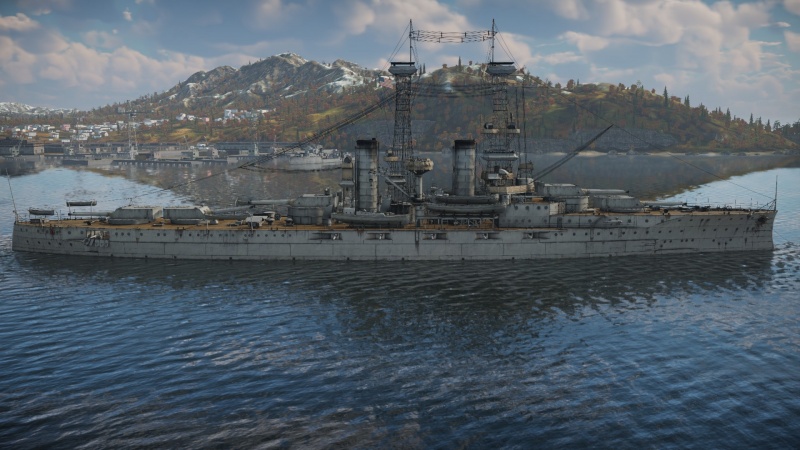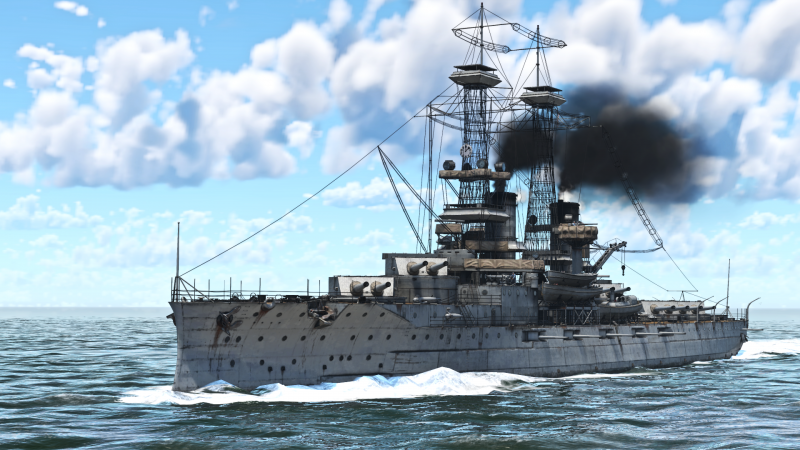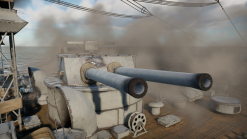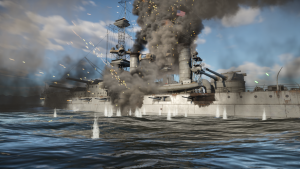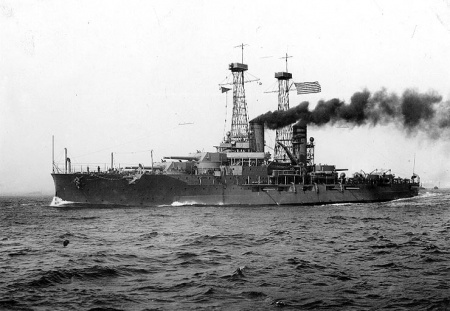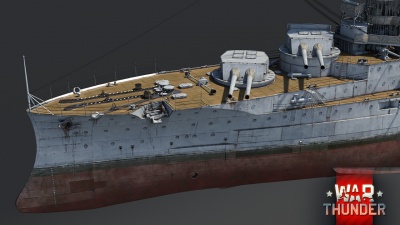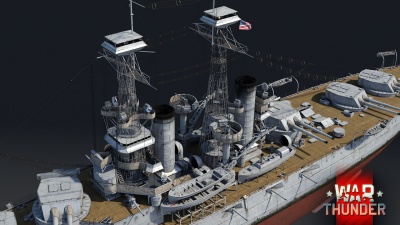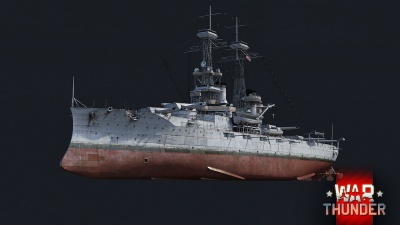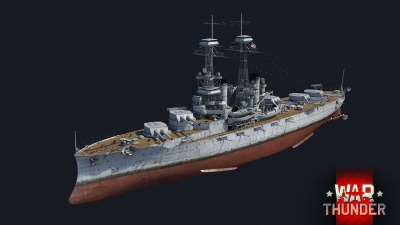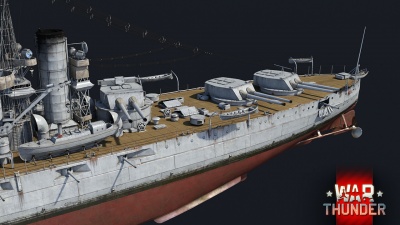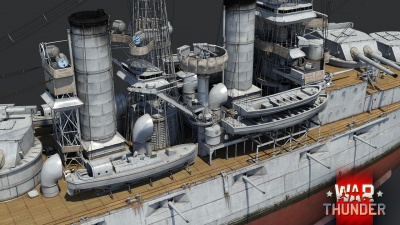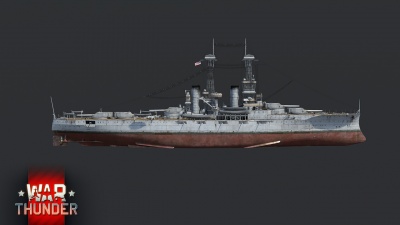Difference between revisions of "USS North Dakota"
(Tag: Visual edit) |
(Modified several portions of text and added two pictures) (Tag: Visual edit) |
||
| (21 intermediate revisions by 11 users not shown) | |||
| Line 1: | Line 1: | ||
| − | {{Specs-Card|code=us_battleship_north_dakota}} | + | {{Specs-Card |
| + | |code=us_battleship_north_dakota | ||
| + | |images={{Specs-Card-Image|GarageImage_{{PAGENAME}}.jpg|ArtImage_{{PAGENAME}}.png}} | ||
| + | }} | ||
== Description == | == Description == | ||
<!-- ''In the first part of the description, cover the history of the ship's creation and military application. In the second part, tell the reader about using this ship in the game. Add a screenshot: if a beginner player has a hard time remembering vehicles by name, a picture will help them identify the ship in question.'' --> | <!-- ''In the first part of the description, cover the history of the ship's creation and military application. In the second part, tell the reader about using this ship in the game. Add a screenshot: if a beginner player has a hard time remembering vehicles by name, a picture will help them identify the ship in question.'' --> | ||
| − | + | The '''{{Specs|name}}''' is one of two Delaware-class battleships laid down for the US Navy. Laid down in 1907, she would be commissioned in 1910. The Delaware class were the first battleships constructed after the size limit of 16,000 tons imposed by the US Congress; as such USS North Dakota was much stronger than the preceding battleships, and along with her sister ship were the first American battleships to exceed 20,000 tons. North Dakota didn't see action during World War One, and while she was present during the occupation of Veracruz in 1914, she did not see any combat. She would be decommissioned under the Washington Naval Treaty and served as a radio-controlled target ship until she was scrapped in 1931. | |
| − | + | ||
| − | The '''{{Specs|name}}''' is a | + | Introduced in [[Update "New Power"]], USS North Dakota was the first battleship added to the American Bluewater fleet. As a contemporary of [[HMS Dreadnought]], North Dakota has ten 12-inch (305mm) guns, the weakest of the American battleships but still respectable for her rank. In her 1919 refit, she has essentially no anti-aircraft defences, and captains should be wary of enemy air, and attempt to sail with an escort when possible for protection. |
== General info == | == General info == | ||
=== Survivability and armour === | === Survivability and armour === | ||
| − | <!-- ''Talk about the vehicle's armour. Note the most well-defended and most vulnerable zones, e.g. the ammo magazine. Evaluate the composition of components and assemblies responsible for movement and manoeuvrability. Evaluate the survivability of the primary and secondary armaments separately. Don't forget to mention the size of the crew, which plays an important role in fleet mechanics. Save tips on preserving survivability for the "Usage in battles" section. If necessary, use a graphical template to show the most well-protected or most vulnerable points in the armour.'' --> | + | {{Specs-Fleet-Armour}} |
| − | + | <!-- ''Talk about the vehicle's armour. Note the most well-defended and most vulnerable zones, e.g. the ammo magazine. Evaluate the composition of components and assemblies responsible for movement and manoeuvrability. Evaluate the survivability of the primary and secondary armaments separately. Don't forget to mention the size of the crew, which plays an important role in fleet mechanics. Save tips on preserving survivability for the "Usage in battles" section. If necessary, use a graphical template to show the most well-protected or most vulnerable points in the armour.'' -->[[File:The turret face of a Dakota after absorbing a 30cm HE shell.png|thumb|247x247px|A turret face on a Dakota after absorbing a 30cm HE shell]] | |
| + | The North Dakota has pretty average armour for a dreadnought. The 279 mm main armour belt and the coal bunkers behind it are more than enough to keep out shells from cruisers, but AP shells from other battleships will punch right through and cause damage to important modules inside the ship. The turrets have thick front armour, but the sides and rear are mediocre and the barbettes are only 254 mm thick and aren't covered by the main belt or coal bunkers. The deck armour ranges from 38 to 51 mm, but will rarely be hit due to how low in the ship it is and the close range of combat in-game. The crew count of 1,384 men is higher than most ships in the game except for ships with large AA complements, meaning that the ship can sustain heavy fire and remain operational. Unfortunately, this ship has one fatal flaw: the ammunition storage sticks out above the waterline and is protected only by the 279 mm armour belt, leaving it easily destroyed by other battleships' armour-piercing shells. | ||
=== Mobility === | === Mobility === | ||
| − | ''Write about the ship's mobility. Evaluate its power and manoeuvrability, rudder rerouting speed, stopping speed at full tilt, with its maximum forward and reverse speed.'' | + | {{Specs-Fleet-Mobility}} |
| + | <!-- ''Write about the ship's mobility. Evaluate its power and manoeuvrability, rudder rerouting speed, stopping speed at full tilt, with its maximum forward and reverse speed.'' --> | ||
| + | The North Dakota is fairly average in terms battleship mobility, reaching 34 km/h stock and 40 km/h spaded. Capturing points and reaching advantageous locations will take a while. The rudder shift time and acceleration are somewhat sluggish, and the ship struggles to manoeuvre evasively. Unless threats and obstacles like torpedoes and islands are spotted well in advance, dodging them will be very difficult. | ||
{{NavalMobility}} | {{NavalMobility}} | ||
| + | |||
| + | === Modifications and economy === | ||
| + | {{Specs-Economy}} | ||
== Armament == | == Armament == | ||
| + | {{Specs-Fleet-Armaments}} | ||
=== Primary armament === | === Primary armament === | ||
| + | {{Specs-Fleet-Primary}} | ||
<!-- ''Provide information about the characteristics of the primary armament. Evaluate their efficacy in battle based on their reload speed, ballistics and the capacity of their shells. Add a link to the main article about the weapon: <code><nowiki>{{main|Weapon name (calibre)}}</nowiki></code>. Broadly describe the ammunition available for the primary armament, and provide recommendations on how to use it and which ammunition to choose.'' --> | <!-- ''Provide information about the characteristics of the primary armament. Evaluate their efficacy in battle based on their reload speed, ballistics and the capacity of their shells. Add a link to the main article about the weapon: <code><nowiki>{{main|Weapon name (calibre)}}</nowiki></code>. Broadly describe the ammunition available for the primary armament, and provide recommendations on how to use it and which ammunition to choose.'' --> | ||
{{main|12-inch/45 Mk.5 (305 mm)}} | {{main|12-inch/45 Mk.5 (305 mm)}} | ||
| − | * 5 | + | * 10 x 12-inch/45 Mk.5 cannons |
| + | |||
| + | The 12-inch/45 Mk.5 makes up North Dakota's main armament, mounted in five twin turrets. The 305 mm cannons come with an ammunition choice of HE (stock) or APCBC unlocked at tier 1. The HE shell hits hard with 33.25 kg of TNT equivalent, and will demolish destroyers and larger ships' superstructures in a handful of salvoes, although this is a relatively low amount of explosive filler compared to the shells of the top battleships. Against other battleships and heavily armoured cruisers, the AP ammunition is the better choice. The AP shell can punch through a maximum of 501 mm of armour at 0° at 1,000 m, and 264 mm at 10 km with 11.78 kg of TNT equivalent. This is a fairly average level of penetration and post-pen damage for this calibre, leaning toward the lower end of capability in comparison. The guns can still penetrate into many capital ships and wreak havoc on cruisers, but will have trouble when it comes to some of the more heavily armoured capital ships they may face, especially at long range. The guns have a stock reload of 39 seconds and a 30-second reload time with maximum skills and an ace crew. Whilst not too underwhelming, the guns just aren't very special and are quickly surpassed in power by other battleships. | ||
| − | + | {{:12-inch/45 Mk.5 (305 mm)/Ammunition|12-inch Cl.B HE, 12-inch Mk.7 APCBC}} | |
=== Secondary armament === | === Secondary armament === | ||
| + | {{Specs-Fleet-Secondary}} | ||
<!-- ''Some ships are fitted with weapons of various calibres. Secondary armaments are defined as weapons chosen with the control <code>Select secondary weapon</code>. Evaluate the secondary armaments and give advice on how to use them. Describe the ammunition available for the secondary armament. Provide recommendations on how to use them and which ammunition to choose. Remember that any anti-air armament, even heavy calibre weapons, belong in the next section. If there is no secondary armament, remove this section.'' --> | <!-- ''Some ships are fitted with weapons of various calibres. Secondary armaments are defined as weapons chosen with the control <code>Select secondary weapon</code>. Evaluate the secondary armaments and give advice on how to use them. Describe the ammunition available for the secondary armament. Provide recommendations on how to use them and which ammunition to choose. Remember that any anti-air armament, even heavy calibre weapons, belong in the next section. If there is no secondary armament, remove this section.'' --> | ||
{{main|5-inch/50 Mk.5 (127 mm)}} | {{main|5-inch/50 Mk.5 (127 mm)}} | ||
| − | * 14 x 5-inch/45 Mk.5 cannons (7 per side) | + | * 14 x 5-inch/45 Mk.5 cannons (7 per side) |
| + | |||
| + | The 127 mm cannons come with Common shells stock and an APC round as a tier I modification. Both shell choices have a measly HE filler and mediocre penetration, and the guns fire at a lacklustre 7 rounds a minute. The best use of these guns is to destroy small PT boats at close range or get some extra damage on destroyers or cruisers between main gun salvoes. | ||
| + | |||
| + | {{:5-inch/50 Mk.5 (127 mm)/Ammunition|5-inch Mk.15 common, 5-inch APC}} | ||
=== Anti-aircraft armament === | === Anti-aircraft armament === | ||
| + | {{Specs-Fleet-AA}} | ||
<!-- ''An important part of the ship's armament responsible for air defence. Anti-aircraft armament is defined by the weapon chosen with the control <code>Select anti-aircraft weapons</code>. Talk about the ship's anti-air cannons and machine guns, the number of guns and their positions, their effective range, and about their overall effectiveness – including against surface targets. If there are no anti-aircraft armaments, remove this section.'' --> | <!-- ''An important part of the ship's armament responsible for air defence. Anti-aircraft armament is defined by the weapon chosen with the control <code>Select anti-aircraft weapons</code>. Talk about the ship's anti-air cannons and machine guns, the number of guns and their positions, their effective range, and about their overall effectiveness – including against surface targets. If there are no anti-aircraft armaments, remove this section.'' --> | ||
{{main|3-inch/50 Mk.10 (76 mm)}} | {{main|3-inch/50 Mk.10 (76 mm)}} | ||
| Line 38: | Line 57: | ||
* 2 x 3-inch/50 Mk.10 cannons (1 per side) | * 2 x 3-inch/50 Mk.10 cannons (1 per side) | ||
| − | === | + | These guns make up the North Dakota's anti-air battery. They are mounted amidships and rather high up. These guns provide very little defence, with a small range, only two guns, a long reload time (for an AA gun), and only time-fused shells. |
| − | <!-- '' | + | |
| + | === Additional armament === | ||
| + | {{Specs-Fleet-Additional}} | ||
| + | <!-- ''Describe the available additional armaments of the ship: depth charges, mines, torpedoes. Talk about their positions, available ammunition and launch features such as dead zones of torpedoes. If there is no additional armament, remove this section.'' --> | ||
{{main|Bliss-Leavitt Mk.1 (533 mm)}} | {{main|Bliss-Leavitt Mk.1 (533 mm)}} | ||
| − | + | The USS North Dakota possesses two 533 mm Bliss-Leavitt Mk.1 Launchers with 6 torpedoes each, making up a total of 12 torpedoes available to fire. These torpedoes are very poor, being designed before World War One. With a short 3.66 km run distance and only 50 km/h speed, hits will be very rare with these weapons. If by some miracle one of these torpedoes does connect to a target, the small 91 kg warhead will deal minimal damage. You're best leaving them behind, since the chance of being crippled by your torpedoes exploding is much higher than the chance of destroying an opponent with them. | |
== Usage in battles == | == Usage in battles == | ||
<!-- ''Describe the technique of using this ship, the characteristics of her use in a team and tips on strategy. Abstain from writing an entire guide – don't try to provide a single point of view, but give the reader food for thought. Talk about the most dangerous opponents for this vehicle and provide recommendations on fighting them. If necessary, note the specifics of playing with this vehicle in various modes (AB, RB, SB).'' --> | <!-- ''Describe the technique of using this ship, the characteristics of her use in a team and tips on strategy. Abstain from writing an entire guide – don't try to provide a single point of view, but give the reader food for thought. Talk about the most dangerous opponents for this vehicle and provide recommendations on fighting them. If necessary, note the specifics of playing with this vehicle in various modes (AB, RB, SB).'' --> | ||
| − | Your main goal as a | + | Your main goal as a dreadnought is to fight and control the battlefield with your high-calibre shells, mainly targeting heavy cruisers and battleships, which can be seriously damaged by good AP hits. It is not advisable to shoot at very lightly armoured cruisers with armour-piercing shells, as the benefits of doing so is lower than shooting at heavier cruisers and battleships. However, these rounds will still do major damage to the interior of any ship, if they penetrate and strike a module. Stay near allies that can be helpful with taking down enemies larger than heavy cruisers. It is recommended not to be part of the main force to push into the battlefield, your ship is slower compared to the other ships that you will be fighting, and if a fight goes sour you can easily be overrun and defeated by the enemy due to focus firing while trying to retreat to a more advantageous position. As an early dreadnought, the ship can easily be damaged or destroyed by the more powerful capital ships in its BR bracket. Try not to draw their attention. |
| − | + | [[File:Dakota under fire.png|thumb|Dakota taking crippling fire from a Kronshtadt]] | |
| − | Stay near friendly ships that can support in the anti-air | + | Stay near friendly ships that can support in the anti-air department. This battleship has very poor anti-air defence capabilities, with only two 76mm guns. It is recommended to stay near ships with effective long-range AA. |
| − | |||
| − | |||
| − | |||
| − | |||
| − | |||
| − | |||
| − | |||
| − | |||
| − | |||
| − | |||
| − | |||
| − | |||
| − | |||
| − | |||
| − | |||
| − | |||
| − | |||
| − | |||
| − | |||
| − | |||
| − | |||
| − | |||
| − | |||
| − | |||
| − | |||
| − | |||
| − | |||
| − | |||
| − | |||
| − | |||
| − | |||
| − | |||
| − | |||
| − | |||
| − | |||
| − | |||
| − | |||
| − | |||
| − | |||
| − | |||
| − | |||
| − | |||
| − | |||
| − | |||
| − | |||
| − | |||
| − | |||
| − | |||
| − | |||
| − | |||
| − | |||
| − | |||
| − | |||
| − | |||
| − | |||
| − | |||
| − | |||
| − | |||
| − | |||
| − | |||
| − | |||
=== Pros and cons === | === Pros and cons === | ||
| Line 116: | Line 77: | ||
'''Pros:''' | '''Pros:''' | ||
| − | * | + | * 5 turrets - losing a turret does not significantly impair your firepower. |
| − | * | + | * Decent armour layout |
| − | * | + | * High number of secondary cannons |
'''Cons:''' | '''Cons:''' | ||
| − | * Slow | + | * Slow and unmanoeuvrable |
| − | * | + | * Near complete lack of anti-air guns |
| − | * | + | * Unexceptional shells |
| − | |||
== History == | == History == | ||
<!-- ''Describe the history of the creation and combat usage of the ship in more detail than in the introduction. If the historical reference turns out to be too long, take it to a separate article, taking a link to the article about the ship and adding a block "/History" (example: <nowiki>https://wiki.warthunder.com/(Ship-name)/History</nowiki>) and add a link to it here using the <code>main</code> template. Be sure to reference text and sources by using <code><nowiki><ref></ref></nowiki></code>, as well as adding them at the end of the article with <code><nowiki><references /></nowiki></code>. This section may also include the ship's dev blog entry (if applicable) and the in-game encyclopedia description (under <code><nowiki>=== In-game description ===</nowiki></code>, also if applicable).'' --> | <!-- ''Describe the history of the creation and combat usage of the ship in more detail than in the introduction. If the historical reference turns out to be too long, take it to a separate article, taking a link to the article about the ship and adding a block "/History" (example: <nowiki>https://wiki.warthunder.com/(Ship-name)/History</nowiki>) and add a link to it here using the <code>main</code> template. Be sure to reference text and sources by using <code><nowiki><ref></ref></nowiki></code>, as well as adding them at the end of the article with <code><nowiki><references /></nowiki></code>. This section may also include the ship's dev blog entry (if applicable) and the in-game encyclopedia description (under <code><nowiki>=== In-game description ===</nowiki></code>, also if applicable).'' --> | ||
| − | + | [[File:USS North Dakota BB-29.jpg|thumb|450x450px|USS North Dakota underway, 1912.]] | |
| + | USS North Dakota (BB-29) was the second ship of the two-ship Delaware class of dreadnoughts, built for the United States Navy (USN) prior to the start of the First World War. The ships were an improved version of the preceding South Carolina class, and carried a heavy armament of high-calibre cannons all mounted on the centreline. North Dakota never saw combat action due to the neutrality of the United States, and served in a variety of training roles during and after the First World War. She was later converted into a radio-controlled target ship, and scrapped by 1931 in compliance with the London naval treaty. | ||
| + | |||
| + | === Design and development === | ||
| + | In 1906, HMS Dreadnought was launched, heralding a new type of super-powerful battleships - the dreadnoughts. The dreadnoughts represented a major shift in naval doctrine, as naval architects had come to favour a larger main battery over a smaller main battery coupled with more secondary guns. As a result, the first American dreadnoughts, the South Carolina class, was launched in 1908. This class featured a variety of innovations, the most important being the positioning of the main battery on the centreline in superfiring pairs - this doctrine was subsequently used by the ships of every major nation. The next class, the Delaware class, continued the trend and mounted a fifth turret. As well, the ship had improved mobility over the dreadfully slow South Carolinas, being capable of making 21 knots. The lead ship, Delaware, was launched in 1909, while the North Dakota was actually launched earlier, in November of 1908. | ||
| + | |||
| + | USS North Dakota displaced 22,400 tons at full load, almost 4,000 tons more than the preceding South Carolina class. The ship's complement consisted of 933 officers and men. Main armament consisted of ten 12-inch (305 mm) guns on five twin turrets - two were located forwards of the superstructure in a superfiring pair while three were located aft, one of them facing forwards in a non-superfiring position. The ship's secondary armament consisted of fourteen 5-inch (127 mm) guns in casemate mountings, two 3-pdr 47 mm guns, and four 1-pdr 37 mm anti-aircraft guns. The ship also carried two submerged 21 inch (533 mm) torpedo tubes. Powered by steam turbines delivering 25,000 shaft horsepower, North Dakota was capable of making 21 knots (39 km/h) - this later became the standard for all American battleships. | ||
| + | |||
| + | === Operational history === | ||
| + | After her commissioning, USS North Dakota fulfilled a variety of training roles and also crossed the Atlantic on her first goodwill voyage to the United Kingdom and France. Following the breakout of war in Europe, North Dakota was assigned to the Atlantic fleet and participated in vigorous training exercises intended to keep sailors ready in the case of an American entry into the First World War. When war was finally declared in 1917, North Dakota remained in the United States, while her sister ship Delaware was sent overseas to fight. As a result, she never saw any active combat. After the end of WWI, North Dakota was used as a training ship for a short period of time before being converted to a radio-controlled target ship. She was eventually scrapped in 1931 after the introduction of the London Naval Treaty. | ||
| + | |||
| + | === [[wt:en/news/6926-development-uss-north-dakota-dreadnought-of-the-new-world-en|Devblog]] === | ||
| + | When the British Dreadnought was built, the United States had been completing their own "all-big-guns" battleship, the South Carolina class. Despite the fact that the new ships were not generally inferior to the British competitor, they were criticized for their small hull size and weak auxiliary artillery. | ||
| + | |||
| + | As a result, the Delaware-class battleships were developed during the mid 1900s. Being larger, better armed and more protected than the preceding South Carolinas, the Delaware-class battleships were ordered for construction and laid down in 1907. The two ships of the class, USS Delaware and USS North Dakota, were both commissioned into service with the USN in April 1910. Although sister ships, USS North Dakota featured a different propulsion system than USS Delaware - namely a steam turbine instead of a traditional steam engine. | ||
| + | |||
| + | Both ships saw only limited action, despite serving through the WWI period. While USS Delaware was operating overseas in European waters, USS North Dakota was kept close to the American shoreline due to concerns about its novel propulsion system. Following the end of WWI, both ships mostly continued their peaceful service until the signing of the Washington Naval Treaty in 1922. | ||
| + | |||
| + | Upon the treaty's signing, the Navy's strength was limited, particularly in battleships. As a result, both of the Delaware-class battleships were gradually put out of service during the 1920s while newer battleships were built to replace them. USS Delaware was broken up for scrap in 1924, while USS North Dakota eventually met the same fate in 1931, after serving as a target ship for several years. | ||
== Media == | == Media == | ||
<!-- ''Excellent additions to the article would be video guides, screenshots from the game, and photos.'' --> | <!-- ''Excellent additions to the article would be video guides, screenshots from the game, and photos.'' --> | ||
| − | + | ||
| + | ;Skins | ||
| + | |||
| + | * [https://live.warthunder.com/feed/camouflages/?vehicle=us_battleship_north_dakota Skins and camouflages for the {{PAGENAME}} from live.warthunder.com.] | ||
| + | |||
| + | ;Images | ||
| + | <gallery mode="packed" caption="USS North Dakota (BB-29) Devblog Images" heights="150"> | ||
| + | File:USS North Dakota WTWallpaper 001.jpg| | ||
| + | File:USS North Dakota WTWallpaper 002.jpg| | ||
| + | File:USS North Dakota WTWallpaper 003.jpg| | ||
| + | File:USS North Dakota WTWallpaper 004.jpg| | ||
| + | File:USS North Dakota WTWallpaper 005.jpg| | ||
| + | File:USS North Dakota WTWallpaper 006.jpg| | ||
| + | File:USS North Dakota WTWallpaper 007.jpg| | ||
| + | </gallery> | ||
== See also == | == See also == | ||
| Line 151: | Line 143: | ||
* [[wt:en/news/6926-development-uss-north-dakota-dreadnought-of-the-new-world-en|[Devblog] USS North Dakota: Dreadnought of the New World]] | * [[wt:en/news/6926-development-uss-north-dakota-dreadnought-of-the-new-world-en|[Devblog] USS North Dakota: Dreadnought of the New World]] | ||
| + | === References === | ||
| + | |||
| + | * Navy History and Heritage Command. (2019). North Dakota (BB 29). Retrieved January 26, 2021, from <nowiki>https://www.history.navy.mil/our-collections/photography/us-navy-ships/battleships/north-dakota-bb-29.html</nowiki> | ||
| + | |||
| + | {{ShipManufacturer Fore River Shipyard}} | ||
{{USA battleships}} | {{USA battleships}} | ||
Latest revision as of 14:57, 6 October 2023
Contents
Description
The Delaware-class, USS North Dakota (BB-29), 1919 is one of two Delaware-class battleships laid down for the US Navy. Laid down in 1907, she would be commissioned in 1910. The Delaware class were the first battleships constructed after the size limit of 16,000 tons imposed by the US Congress; as such USS North Dakota was much stronger than the preceding battleships, and along with her sister ship were the first American battleships to exceed 20,000 tons. North Dakota didn't see action during World War One, and while she was present during the occupation of Veracruz in 1914, she did not see any combat. She would be decommissioned under the Washington Naval Treaty and served as a radio-controlled target ship until she was scrapped in 1931.
Introduced in Update "New Power", USS North Dakota was the first battleship added to the American Bluewater fleet. As a contemporary of HMS Dreadnought, North Dakota has ten 12-inch (305mm) guns, the weakest of the American battleships but still respectable for her rank. In her 1919 refit, she has essentially no anti-aircraft defences, and captains should be wary of enemy air, and attempt to sail with an escort when possible for protection.
General info
Survivability and armour
The North Dakota has pretty average armour for a dreadnought. The 279 mm main armour belt and the coal bunkers behind it are more than enough to keep out shells from cruisers, but AP shells from other battleships will punch right through and cause damage to important modules inside the ship. The turrets have thick front armour, but the sides and rear are mediocre and the barbettes are only 254 mm thick and aren't covered by the main belt or coal bunkers. The deck armour ranges from 38 to 51 mm, but will rarely be hit due to how low in the ship it is and the close range of combat in-game. The crew count of 1,384 men is higher than most ships in the game except for ships with large AA complements, meaning that the ship can sustain heavy fire and remain operational. Unfortunately, this ship has one fatal flaw: the ammunition storage sticks out above the waterline and is protected only by the 279 mm armour belt, leaving it easily destroyed by other battleships' armour-piercing shells.
Mobility
The North Dakota is fairly average in terms battleship mobility, reaching 34 km/h stock and 40 km/h spaded. Capturing points and reaching advantageous locations will take a while. The rudder shift time and acceleration are somewhat sluggish, and the ship struggles to manoeuvre evasively. Unless threats and obstacles like torpedoes and islands are spotted well in advance, dodging them will be very difficult.
| Mobility Characteristics | |||
|---|---|---|---|
| Game Mode | Upgrade Status | Maximum Speed (km/h) | |
| Forward | Reverse | ||
| AB | |||
| Upgraded | 46 | 21 | |
| RB/SB | |||
| Upgraded | 40 | 18 | |
Modifications and economy
Armament
Primary armament
- 10 x 12-inch/45 Mk.5 cannons
The 12-inch/45 Mk.5 makes up North Dakota's main armament, mounted in five twin turrets. The 305 mm cannons come with an ammunition choice of HE (stock) or APCBC unlocked at tier 1. The HE shell hits hard with 33.25 kg of TNT equivalent, and will demolish destroyers and larger ships' superstructures in a handful of salvoes, although this is a relatively low amount of explosive filler compared to the shells of the top battleships. Against other battleships and heavily armoured cruisers, the AP ammunition is the better choice. The AP shell can punch through a maximum of 501 mm of armour at 0° at 1,000 m, and 264 mm at 10 km with 11.78 kg of TNT equivalent. This is a fairly average level of penetration and post-pen damage for this calibre, leaning toward the lower end of capability in comparison. The guns can still penetrate into many capital ships and wreak havoc on cruisers, but will have trouble when it comes to some of the more heavily armoured capital ships they may face, especially at long range. The guns have a stock reload of 39 seconds and a 30-second reload time with maximum skills and an ace crew. Whilst not too underwhelming, the guns just aren't very special and are quickly surpassed in power by other battleships.
| Penetration statistics | |||||||
|---|---|---|---|---|---|---|---|
| Ammunition | Type of warhead |
Penetration @ 0° Angle of Attack (mm) | |||||
| 1,000 m | 2,500 m | 5,000 m | 7,500 m | 10,000 m | 15,000 m | ||
| Cl.B HE | HE | 68 | 68 | 68 | 68 | 68 | 68 |
| Mk.7 APCBC | APCBC | 501 | 447 | 371 | 311 | 264 | 204 |
| Shell details | ||||||||||||
|---|---|---|---|---|---|---|---|---|---|---|---|---|
| Ammunition | Type of warhead |
Velocity (m/s) |
Projectile mass (kg) |
Fuse delay (s) |
Fuse sensitivity (mm) |
Explosive mass (TNT equivalent) (kg) |
Ricochet | |||||
| 0% | 50% | 100% | ||||||||||
| Cl.B HE | HE | 823 | 335.65 | 0 | 0.1 | 33.25 | 79° | 80° | 81° | |||
| Mk.7 APCBC | APCBC | 823 | 394.6 | 0.035 | 17 | 11.78 | 48° | 63° | 71° | |||
Secondary armament
- 14 x 5-inch/45 Mk.5 cannons (7 per side)
The 127 mm cannons come with Common shells stock and an APC round as a tier I modification. Both shell choices have a measly HE filler and mediocre penetration, and the guns fire at a lacklustre 7 rounds a minute. The best use of these guns is to destroy small PT boats at close range or get some extra damage on destroyers or cruisers between main gun salvoes.
| Penetration statistics | |||||||
|---|---|---|---|---|---|---|---|
| Ammunition | Type of warhead |
Penetration @ 0° Angle of Attack (mm) | |||||
| 1,000 m | 2,500 m | 5,000 m | 7,500 m | 10,000 m | 15,000 m | ||
| 5-inch Mk.15 common | Common | 108 | 92 | 70 | 54 | 42 | 30 |
| 5-inch APC | APC | 179 | 152 | 116 | 89 | 69 | 49 |
| Shell details | ||||||||||||
|---|---|---|---|---|---|---|---|---|---|---|---|---|
| Ammunition | Type of warhead |
Velocity (m/s) |
Projectile mass (kg) |
Fuse delay (s) |
Fuse sensitivity (mm) |
Explosive mass (TNT equivalent) (g) |
Ricochet | |||||
| 0% | 50% | 100% | ||||||||||
| 5-inch Mk.15 common | Common | 914 | 22.68 | 0.005 | 6 | 780 | 47° | 60° | 65° | |||
| 5-inch APC | APC | 914 | 22.68 | 0.015 | 5 | 770 | 48° | 63° | 71° | |||
Anti-aircraft armament
- 2 x 3-inch/50 Mk.10 cannons (1 per side)
These guns make up the North Dakota's anti-air battery. They are mounted amidships and rather high up. These guns provide very little defence, with a small range, only two guns, a long reload time (for an AA gun), and only time-fused shells.
Additional armament
The USS North Dakota possesses two 533 mm Bliss-Leavitt Mk.1 Launchers with 6 torpedoes each, making up a total of 12 torpedoes available to fire. These torpedoes are very poor, being designed before World War One. With a short 3.66 km run distance and only 50 km/h speed, hits will be very rare with these weapons. If by some miracle one of these torpedoes does connect to a target, the small 91 kg warhead will deal minimal damage. You're best leaving them behind, since the chance of being crippled by your torpedoes exploding is much higher than the chance of destroying an opponent with them.
Usage in battles
Your main goal as a dreadnought is to fight and control the battlefield with your high-calibre shells, mainly targeting heavy cruisers and battleships, which can be seriously damaged by good AP hits. It is not advisable to shoot at very lightly armoured cruisers with armour-piercing shells, as the benefits of doing so is lower than shooting at heavier cruisers and battleships. However, these rounds will still do major damage to the interior of any ship, if they penetrate and strike a module. Stay near allies that can be helpful with taking down enemies larger than heavy cruisers. It is recommended not to be part of the main force to push into the battlefield, your ship is slower compared to the other ships that you will be fighting, and if a fight goes sour you can easily be overrun and defeated by the enemy due to focus firing while trying to retreat to a more advantageous position. As an early dreadnought, the ship can easily be damaged or destroyed by the more powerful capital ships in its BR bracket. Try not to draw their attention.
Stay near friendly ships that can support in the anti-air department. This battleship has very poor anti-air defence capabilities, with only two 76mm guns. It is recommended to stay near ships with effective long-range AA.
Pros and cons
Pros:
- 5 turrets - losing a turret does not significantly impair your firepower.
- Decent armour layout
- High number of secondary cannons
Cons:
- Slow and unmanoeuvrable
- Near complete lack of anti-air guns
- Unexceptional shells
History
USS North Dakota (BB-29) was the second ship of the two-ship Delaware class of dreadnoughts, built for the United States Navy (USN) prior to the start of the First World War. The ships were an improved version of the preceding South Carolina class, and carried a heavy armament of high-calibre cannons all mounted on the centreline. North Dakota never saw combat action due to the neutrality of the United States, and served in a variety of training roles during and after the First World War. She was later converted into a radio-controlled target ship, and scrapped by 1931 in compliance with the London naval treaty.
Design and development
In 1906, HMS Dreadnought was launched, heralding a new type of super-powerful battleships - the dreadnoughts. The dreadnoughts represented a major shift in naval doctrine, as naval architects had come to favour a larger main battery over a smaller main battery coupled with more secondary guns. As a result, the first American dreadnoughts, the South Carolina class, was launched in 1908. This class featured a variety of innovations, the most important being the positioning of the main battery on the centreline in superfiring pairs - this doctrine was subsequently used by the ships of every major nation. The next class, the Delaware class, continued the trend and mounted a fifth turret. As well, the ship had improved mobility over the dreadfully slow South Carolinas, being capable of making 21 knots. The lead ship, Delaware, was launched in 1909, while the North Dakota was actually launched earlier, in November of 1908.
USS North Dakota displaced 22,400 tons at full load, almost 4,000 tons more than the preceding South Carolina class. The ship's complement consisted of 933 officers and men. Main armament consisted of ten 12-inch (305 mm) guns on five twin turrets - two were located forwards of the superstructure in a superfiring pair while three were located aft, one of them facing forwards in a non-superfiring position. The ship's secondary armament consisted of fourteen 5-inch (127 mm) guns in casemate mountings, two 3-pdr 47 mm guns, and four 1-pdr 37 mm anti-aircraft guns. The ship also carried two submerged 21 inch (533 mm) torpedo tubes. Powered by steam turbines delivering 25,000 shaft horsepower, North Dakota was capable of making 21 knots (39 km/h) - this later became the standard for all American battleships.
Operational history
After her commissioning, USS North Dakota fulfilled a variety of training roles and also crossed the Atlantic on her first goodwill voyage to the United Kingdom and France. Following the breakout of war in Europe, North Dakota was assigned to the Atlantic fleet and participated in vigorous training exercises intended to keep sailors ready in the case of an American entry into the First World War. When war was finally declared in 1917, North Dakota remained in the United States, while her sister ship Delaware was sent overseas to fight. As a result, she never saw any active combat. After the end of WWI, North Dakota was used as a training ship for a short period of time before being converted to a radio-controlled target ship. She was eventually scrapped in 1931 after the introduction of the London Naval Treaty.
Devblog
When the British Dreadnought was built, the United States had been completing their own "all-big-guns" battleship, the South Carolina class. Despite the fact that the new ships were not generally inferior to the British competitor, they were criticized for their small hull size and weak auxiliary artillery.
As a result, the Delaware-class battleships were developed during the mid 1900s. Being larger, better armed and more protected than the preceding South Carolinas, the Delaware-class battleships were ordered for construction and laid down in 1907. The two ships of the class, USS Delaware and USS North Dakota, were both commissioned into service with the USN in April 1910. Although sister ships, USS North Dakota featured a different propulsion system than USS Delaware - namely a steam turbine instead of a traditional steam engine.
Both ships saw only limited action, despite serving through the WWI period. While USS Delaware was operating overseas in European waters, USS North Dakota was kept close to the American shoreline due to concerns about its novel propulsion system. Following the end of WWI, both ships mostly continued their peaceful service until the signing of the Washington Naval Treaty in 1922.
Upon the treaty's signing, the Navy's strength was limited, particularly in battleships. As a result, both of the Delaware-class battleships were gradually put out of service during the 1920s while newer battleships were built to replace them. USS Delaware was broken up for scrap in 1924, while USS North Dakota eventually met the same fate in 1931, after serving as a target ship for several years.
Media
- Skins
- Images
- USS North Dakota (BB-29) Devblog Images
See also
Links to articles on the War Thunder Wiki that you think will be useful for the reader, for example:
- reference to the series of the ship;
- links to approximate analogues of other nations and research trees.
External links
References
- Navy History and Heritage Command. (2019). North Dakota (BB 29). Retrieved January 26, 2021, from https://www.history.navy.mil/our-collections/photography/us-navy-ships/battleships/north-dakota-bb-29.html
| Fore River Shipyard | |
|---|---|
| Battleships (BB) | |
| Delaware-class | USS North Dakota |
| Nevada-class | USS Nevada |
| Note | Fore River Shipyard was purchased by Bethlehem Steel Corp. in 1913. |
| USA battleships | |
|---|---|
| Delaware-class | USS North Dakota |
| Wyoming-class | USS Wyoming · USS Arkansas |
| New York-class | USS Texas |
| Nevada-class | USS Nevada |
| Pennsylvania-class | USS Arizona |
| New Mexico-class | USS Mississippi |
| Tennessee-class | USS Tennessee |



